Have you ever been somewhere, learning so much information that you just had to take notes and hopefully be able to understand it all later via Dr. Google searches? I know it sounds like college, but that’s how I felt at the recent Inflammatory Breast Cancer (IBC) Conference that I crashed. It wasn’t a bad thing. I feel like the more I understand of the disease, the better patient and advocate I can be. It was thrilling and invigorating.
I heard about the 7th Annual Inflammatory Breast Cancer Conference via Facebook support groups. It’s geared towards doctors, researchers and nurses working in the IBC sphere, but is open to patients as well. I thought that since I had a pretty good grasp on IBC, the conference was put on by MD Anderson, and was located in Houston, Texas; so I thought let’s go! We can learn and see a lot of cancer friends as my AYA support group is based out of MD Anderson.
We had originally decided to go to the conference over the summer. I booked all the rooms in September, was super excited, and then grandma passed. The insurmountable pain, grief and energy both those things take had me questioning even going. But as my oncology therapist Kevin taught me, sometimes you have to put out a little energy to refill your energy and happiness buckets. The output is less than the input.
Even though I knew it would be easier to stay home, my soul kept urging me to go. Our journey to Houston started early on Friday morning after an oncology appointment. Within moments of leaving the house, chaos struck.
See—when I left the house, Oliver was sitting in his wait spot in the basement, away from the door leading to the garage. He was sitting in his spot so nicely. I was so proud! We leave the house to head to oncology and head down the street. We got a block and a half away from our house (to 50th street), when Mitch yelled “Julia!” I look over and there is Oliver! Sitting on the street between our car and the stop sign looking at me like, ”Where are we going, mom? I’ll keep up!” What a start to a two-day road trip! We turned around, took the naughty sausage delinquent home and made sure Able was still at home, which he was. The old man prince had not even noticed nor cared that absolute chaos and panic had just occurred.
Oncology Visit
We got back on our way and arrived at oncology right on time for blood work. There was a huge queue to get it done and I got nervous. I thought certainly we would be late. But we lucked out! All the patients were waiting for port access blood draws and since I don’t have a port anymore, I could jump the line. I felt famous but also bad. The protocol had recently changed and Methodist only allows nurses to access ports now. It was the first day of this new policy and a struggle. They only have one nurse to access ports when most cancer patients get blood done this way. The poor phlebotomists were standing around with their hands tied, while this one nurse was attempting to do all the work. Hopefully they hire more nurses soon for my cancer friends, because that’s going to slow everything way down.
Anyway we got the blood work done and up to oncology. I sported my bright pink Juicy Couture jumpsuit, and was bubbly and loud as always. I was chatting up my favorite receptionist, showing off my new cancer tattoos, and having a blast. Man did I get a lot of stares from all the sad little old senior citizens in the waiting room!!! I wonder if they thought I was a caregiver and super disrespectful of the vibe they were going for or if they realized I was just a patient who was over the moon to just be alive.
Dr. Wells was quite well and amazing as always. We talked about the end date for my oral chemo!!! It will be in the next month or two!!!! We then talked about starting Verzenio. Now I need you to think back to biology really quickly for me. Cells multiply and divide, creating more cells. This is called mitosis. One part of this involves enzymes called CDK4 and CDK6. Verzenio inhibits CDK4 and CDK6 so that cancer cells can not complete mitosis. Meaning they can’t multiply. Meaning the cancer ceases to exist. Isn’t this so cool! It’s biology literally in action!!! All that stuff you learned in high school or college happening in real time and saving lives! It just gets me so jazzed when the practical application is so apparent.
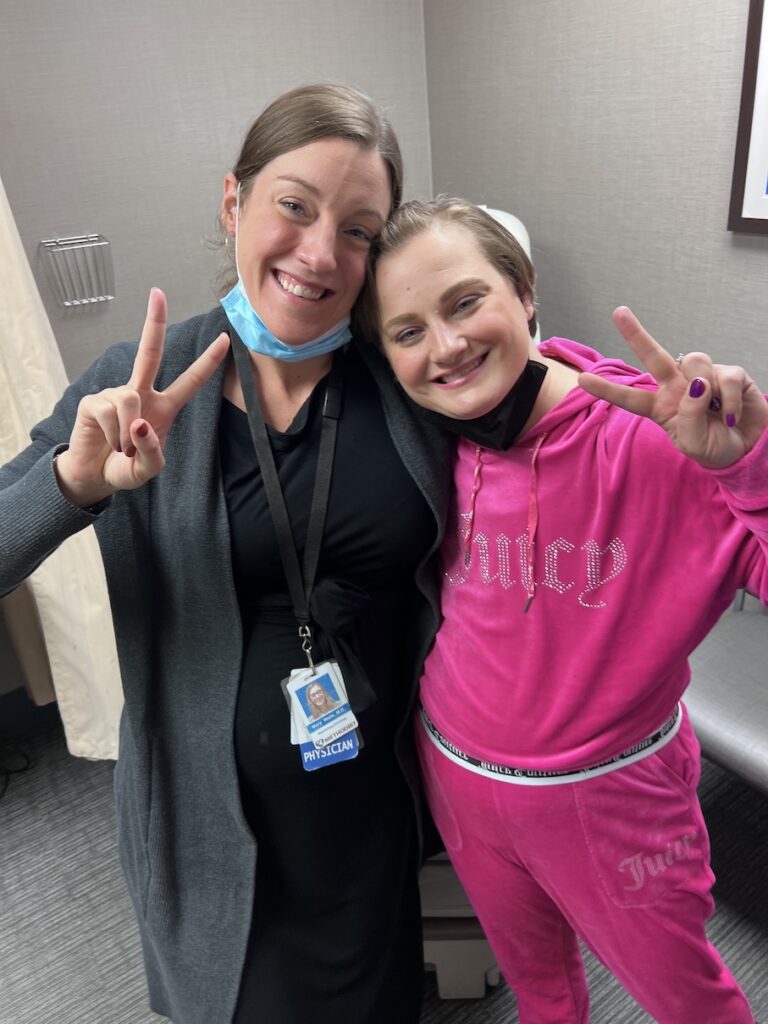
Anyway science aside, Dr. Wells and I talked about verzenio start dates and duration of treatment. I thought it was going to be throughout my entire ten year stint on hormone blocker letrozole which I wasn’t too jazzed about, but turns out it’s only two years! That’s really exciting!!! I can do two years of another drug easy peasy!
We decided that I would wait to start this drug until my follow up in late February. There are a lot of reasons for this, but it all boils down to quality of life and risk assessment. The current research says it’s okay to wait and take short breaks from these long term medications. That, coupled with my medication burnout, physical exhaustion and mounting side effects, the decision was simple–let’s wait and give my body and soul a break. I need a bit of a recharge to continue on in the healthiest way possible, because mental fortitude is well over half of this metaphorical battle.
That right there is why I am always and forever singing Dr. Wells‘ praises. Because she looked at my life as a whole and developed a treatment plan with me that is tailored specifically to my situation. She knows the latest research and what risks we can take to still provide me the same outcomes. She’s truly an angel on earth improving the lives of so many patients through her own modernized practice of medicine and is an example to other doctors of how to treat the whole patient. I know my nursing practice has evolved because of her. I’m forever grateful for her and everyone who shaped her into the amazing doctor she is.
Road Trip in a Tesla!
Anyway, after oncology we hit the road for Houston. It was our first big road trip in the Tesla so a learning experience was to be had. I’m glad we got to do it and am now much better prepared for our next road trip. To answer the questions everyone asks us ahead of time…. no, stopping did not add a lot of extra time to our trip. Based on driving habits coupled with weather conditions, the Tesla maps out where you have to stop to charge. Some of the charging station locations are better than others. One in Kansas was near nothing, but most were within walking distance to shops, food or gas stations to use the restroom and fuel our bodies. Our charging stops were 15-30 minutes, depending on the location. We drove about 7–8 hours both days of travel to Houston with two stops on each leg of the trip for charging. It cost about $20 (or less) for each charge.
I learned that taking a roadtrip in a Tesla (ours is called Remy) requires a different mindset. When I’ve road tripped in the past, I would stop whenever I wanted to pee or refuel. Remy plans it for me now down to the minute which was just different and something I was not used to. Stopping for a set amount of time was just a different feeling too. We learned that I do better if I can go explore while Remy charges and Mitch enjoys playing a farm game that’s installed as a mental mind break. We also prefer to stop and grab food to eat in Remy while she charges. It felt like we wasted less time that way than sitting down to eat and waiting on sit down service.
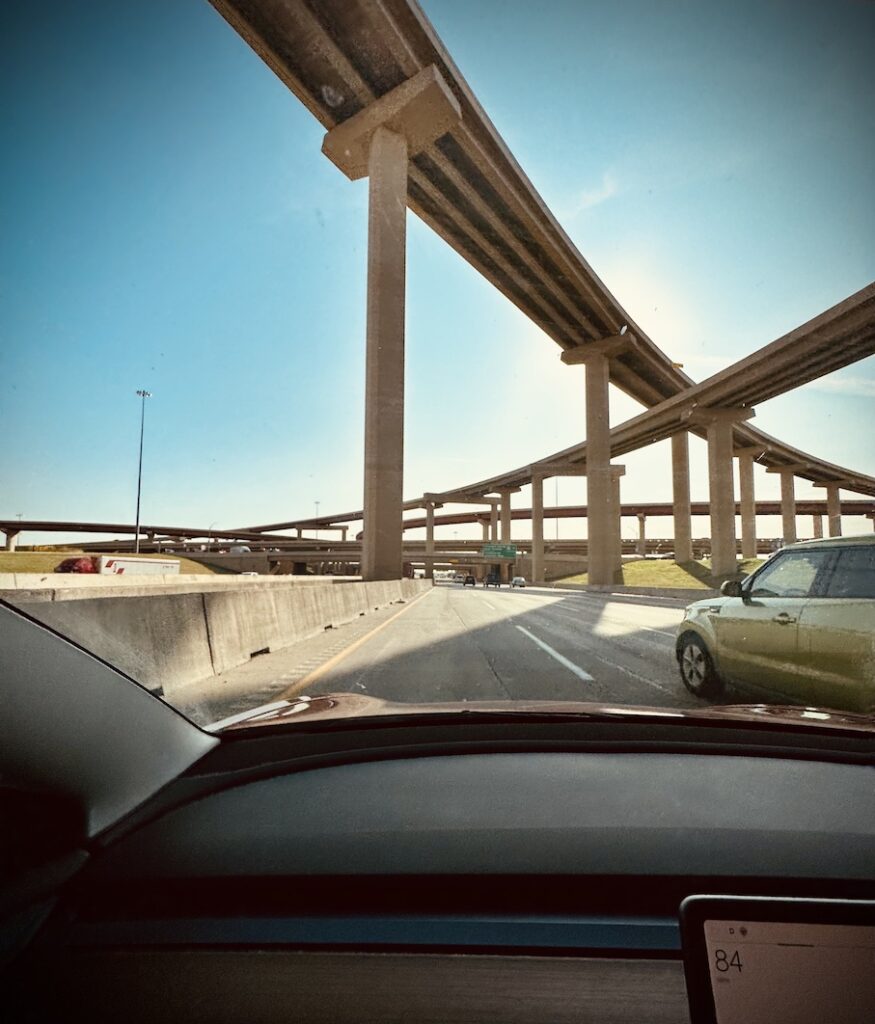
Overall, it was so much more enjoyable. We enabled Full Self Driving (FSD), which was absolutely wild! We would set the max speed and Remy did basically everything else. We just had to keep a slight turning pressure on the wheel at all times or it would disable FSD. Remy would speed up or slow down based on traffic, she’d always want to be in the right lane unless it was slow and then would pass the other cars, which we would confirm with a tap of the blinker. There was only one issue that jolted Mitch awake when Remy got confused and tried to take an exit when that wasn’t necessary. She also liked to take back highways; which I’m not sure if that was a user error, Remy determining it would be faster or better for the battery because of decreased wind, or whatever else. But we let her call the shots for the most part and it worked out great. The mental strain of not having to fully drive, and just being able to enjoy the sights (when there were any) was great. If you can, I 100% suggest getting an electric vehicle. It is worth every single penny.
We stopped the night in Perry, Okla., in one of the nicest overnight hotels I’ve ever stayed in, the Microtel. I don’t know what they had going on, but it didn’t smell like a hotel or fake scents trying to cover “hotel smell.” It just smelled wonderful. It was decorated for Christmas better than any expensive hotel. It was quiet and just a joy to stay there. It was like a retreat!
Day 2 of Travel & AYA Reunion
We got on the road super early on Saturday, because the AYA support group I’m part of was hosting an afternoon s’mores party in Houston. I was a bit worried we wouldn’t arrive on time, but thanks to Mitch driving, we did! And I’m so glad we did. We got to see the amazing Wendy, a social worker for AYAs at MD Anderson and true champion for AYAs, and a ton of friends. We went to an amazing dinner after the meet up at the deliciously greek Niko Nikos with a few of those friends. We were at the restaurant for almost 2 hours eating, being present, and feeling seen/accepted. It’s in those rare moments with AYA friends that I’m normal and can drop the mask I have to wear everyday to make everyone comfortable with the fact that I’m a cancer patient and living miracle. It’s in those moments with cancer friends that I can just be. Everything is not only accepted, but understood and normalized. We bitch and complain about things only each other understands; a “trauma bond” some may say, but we know it’s more than that.

IBC Conference
The conference started on Sunday and they wasted no time getting right down to the science of it all. They hit the ground running with riveting talks titled Novel Systemic Therapies for MBC, Brain Mets and LMD, Oligomet Radiation, and Latest Treatment in IBC. From the moment the first speaker started talking, I knew I was in for an interesting time. While most of it went straight over my head, I did my best to stay engaged, take notes and learn what I could. I was sitting among the best in the entire world for treatment of IBC and I wanted to soak it all in. I felt a very strong responsibility to represent IBC patients as a whole.
There were only a handful of us there and I wanted to be present to remind these brilliant minds why they are doing what they are doing, and show that patients can understand the complicated science involved in treatment if you just take the time to explain it or lead us to the resources to learn on our own. For me (and I’m sure other patients) it brings much peace to know about the drugs we are taking and how they work. I am happy to say that while there was a big focus on the science, there was also much talk about the patient and quality of life, something I preach all the time and is most important in cancer care.
The Science
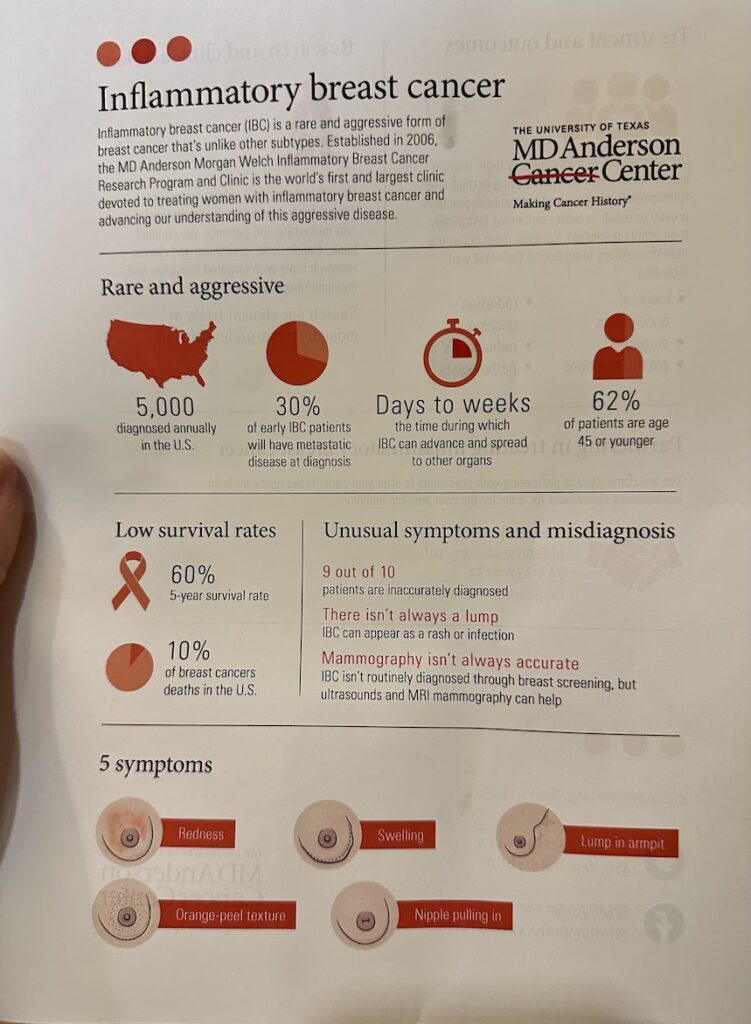
I learned about all sorts of things. There won’t be much rhyme or reason here. Just an outpouring of what I learned. I learned about Xgeva which is an alternative to Xometa. Both drugs are given to patients with high risk of bone issues. In support groups, I’ve found that oftentimes Xometa isn’t tolerated well and found out Xgeva is an alternative that can be given sub Q and has less side effects. It’s a second line treatment; meaning it’s given if a different drug fails. Failure can be as simple as a nurse documenting the flu-like symptoms it can cause and then insurance would cover Xgeva.
HER2 & HER3
Some other random things I learned/expanded growth on… a lot of HER2 drugs can cross the blood/brain barrier. The blood/brain barrier is very hard to cross and most drugs don’t so this is great news. The fact that HER2 drugs can cross this barrier is great for IBC, because IBC likes to metastasis to the brain. This means that if a patient is HER2 positive with brain mets, there are drugs to treat it. Just more chances at staying alive.
There was lots of talk about triple negative breast cancer. Triple negative breast cancer means there are no sites on the cancer cell that accept a hormone or protein to make it grow. As far as science knows it just grows on its own. A lot of research was presented to figure out what is making triple negative cancer grow. This is really important because to further categorize triple negatives into different subtypes, they can have their own molecular treatments which have shown in hormone positive and HER2 positive cancers to drastically improve long term survival.
One of the things they have found that makes some triple negative cancers grow is a protein receptor called HER3. Thirty percent of triple negative cancers are HER3 positive. If we can treat those patients with a drug for HER3, it can improve their survival. There are studies going on right now that were presented about how effective the drugs are showing to be. This means that hopefully within the next 10 years we will have a new subclass of breast cancer and even more treatments, meaning keeping people alive!
The other big thing for triple negative is the fact that 30-40% of triple negative patients are HER2 Low. This is really important, because HER2 Low can receive HER2 treatments that already exist and potentially prolong life. I also learned that cancer needs to be tested for its receptors at every chance there is (meaning at biopsies and surgery), because not every sample can have all the receptors. What may have been treated as HER2 negative can change into HER2 positive and add treatment options, because the first sample just didn’t have any of those cells on it. Nobody did anything wrong, nobody missed anything— it just didn’t make it on that slide because it’s a spectrum when it comes to subtyping cancer. It’s a certain percentage of cells showing those receptors, and sometimes the percentage is so low it just doesn’t show up on every sample.
A lot of patients in support groups get very frustrated with a different subtype diagnosis, because nobody is explaining that not every single cell may show these receptors. It leads to questioning the doctors and not believing the treatment options. Understanding that cancer subtypes are not so black and white is so important for patients to understand and I’m really excited to take that knowledge back to my support groups. I can explain that it’s nobody’s fault, that it’s a good thing, that you have more treatment options now, and that patients have a better chance at complete response or no evidence of disease status. Patients can now have a curative intent as long as they just keep the faith and trust the doctors. I hope it has as big of an impact as I think it will.
Subtype Changes
Just a side note, there’s lots of subtype switching in brain mets and IBC. Right now, brain mets aren’t always restaged/typed. Nobody saw the need for it. But some researchers did the work and found out how important it is to do. Performing and funding that research should be shown to insurance companies that brain mets need to be restaged and tested in case there are changes that can be made to the treatment plan and prolong life. Research saves lives by showing the need for these things. Research is what makes insurance companies have to pay for things.
Brain MRIs
On the idea of paying for things. There was a push for escalating screening in order to de-escalate therapy. Meaning doing things like brain MRIs sooner for IBC patients, because of our increased risk. If it’s caught sooner, then radiation can potentially be avoided, saving money in the long run. It’s just the upfront cost of paying for an MRI. Through research and proving that catching it before symptoms makes a difference in the amount of therapies needed, then insurance can cover MRIs sooner. It seems simple but we have to do it. We have to fund this research to really make a difference for the patients.
Hormone Positive Only
Lightly touched on was IBC subtype hormone positive only. So no HER2 receptors, which is the subtype I had. In the last 5–10 years, it’s been found that with hormone positive breast cancers, the cyclin and kinases proteins involved in the mitosis process are overproduced and thus resulting in more cancer cells. Drugs have been made to inhibit some of these proteins, specifically the CDK4 and CDK6 proteins. This is Verzenio! You know, the drug I’m going to be taking soon! There was lots of talk about this drug and when to take, for how long, and what other drugs can be taken with it, specifically the oral chemo I am coming off soon. There’s no data on whether these 2 drugs should be taken congruently, back to back, their toxicity, or really any data at all. It’s the wild west of breast cancer care that I’m certain will be investigated soon.
I have another note that I don’t 100% know what I was talking about, but I’m 99% sure of. It basically states that in estrogen positive IBC, the curve for long term survival doesn’t change with certain treatments like it does for non-IBC patients. Which does not induce the warm fuzzies for me, because it means that estrogen positive IBC patients don’t respond to therapy as well and die more often/sooner than their non-IBC patient peers. There wasn’t a clear understanding of why this is, but there was talk of how to investigate it.
SERDS
The data showing that hormone positive IBC long term survival cure doesn’t change with certain treatments as it does for non-IBC patients, leading to an emphasis on the need for research on SERDS. SERDS are selective estrogen receptor degraders; basically a fancy way of saying how they stop estrogen production. I guess in some patients (specifically IBC patients for sure) the typical estrogen blocking drugs stop working after some time. There is a need to make more SERD medication, because once the typical or 1st line estrogen blocking drugs stop working metastatic disease appears. Metastatic disease kills. Soooooo more SERD drugs would save lives.
MARCKS Proteins
The one research I heard about that I’m super excited about is into Myristoylated Alanine-Rich C Kinase Substrate or MARCKS proteins. MARCKS proteins are villains and get involved with the pi3k/akt pathway. Pi3k/akt pathway is like part of a sauce that has to be made in the overall recipe of cellular mitosis. MARCKS proteins weasel their way in the making of that pi3k/akt pathway turning things into cancer. The thinking and what is being tested is blocking MARCKS proteins to inhibit its ability to affect the pi3k/akt pathway so that cancer can’t complete its growth cycle and thus is killed. Why is this all so important to IBC? MARCKS proteins were found to be disproportionately elevated in a large population of IBC patients versus non IBC patients. When these proteins are found there are higher risks of metastasis and lower long term survival. By investigating this protein and understanding its unique effect on breast cancer cells, drugs are now being developed to block the MARCKS protein and save lives. HOW COOL IS THAT?!?!?! I’m geeking out so hard right now!
KOMEN Scoring
They also discussed the new KOMEN scoring criteria for IBC. Which is so important in getting an ICD10 number. ICD10 numbers are codes that tell insurance companies xyz treatment is needed for xyz disease. Having an ICD10 number would mean IBC is a recognized disease with its own treatment needs. WIthout an ICD10 code specific for IBC treatments that we need can and are being denied every day. The KOMEN scoring is moving on to next phases and hopefully will become the standard of care/diagnosis standard soon.
Quality of Life
Finally the one thing I really really appreciate was how Dr. Ueno from MD Anderson put an emphasis on IBC can be treated outside of IBC specific clinics as long as the doctors are working together. Which was beautiful. He stressed quality of life, involving palliative care early, sitting with patients and families and hearing their concerns, making treatment and progression of treatment decisions based on the specific patient and their wants/needs. Basically utilizing critical thinking skills to determine what’s going to bring this one patient the best quality of life and meet their own goals. Because sometimes the end goal isn’t curative and we need to not always treat it as such. He also stressed the importance of survivorship, psychosocial symptoms, and just treating the patient as a whole. Hearing this at a conference for providers, it was beautiful and I teared up. It’s everything I want for my peers.
Fun in Texas
Wasn’t that a lot! It’s just a small glimpse into the conference and what I learned. While we weren’t at the conference, we had some great fun in Texas. We drove down to Galvenston and went to the beach. Everyone has been giving me such a hard time about going to Galvenston, but to me it was beautiful. For me, the ocean is like pizza, any is better than none. While in Galveston, we also happened upon a Dickens festival. It was so much fun! They even had fake snow for the kids!! That cracked us up!
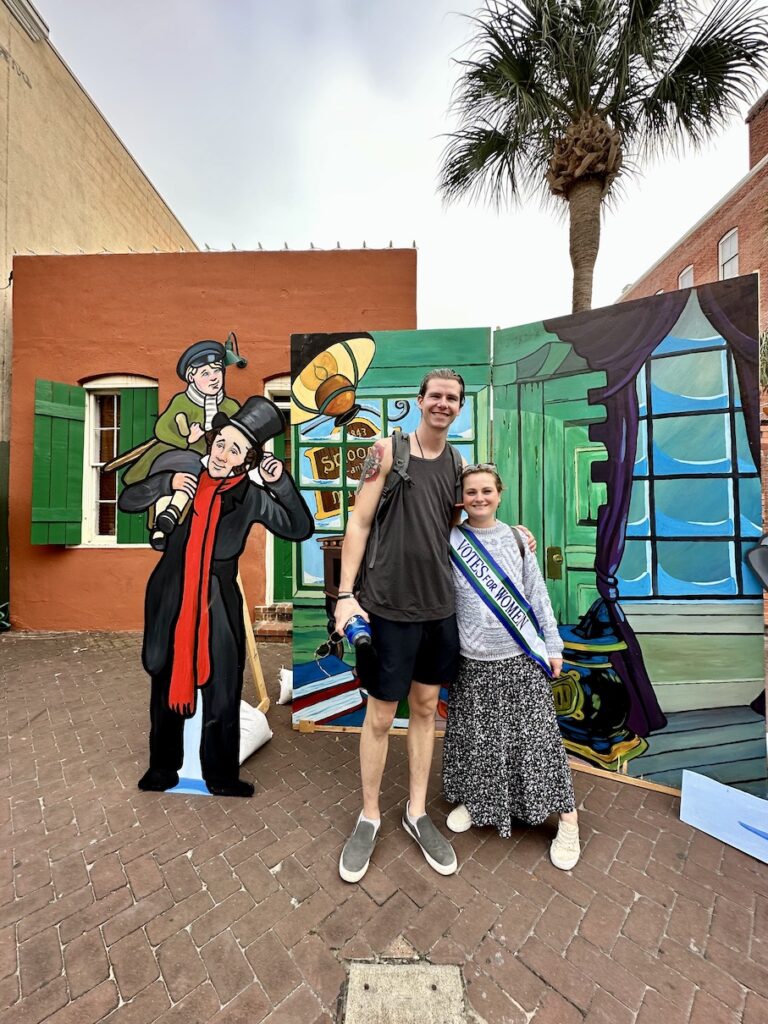
After the festival, we met up again with AYA friends at the Post Market in one of Houston’s many downtown districts. It was an awesome food hall that had a market going on at the same time. They also had a beautiful rooftop area that was so much fun to be at. We again spent a couple of hours with our friends. It was so fun and I could have spent even longer there, but I was so exhausted and my body was about to shut down. At one point I blinked and felt like I fell asleep, so we had to go back to the hotel then.
Moving Forward
Now we’re back home and you might be seeing my face around town more often. Methodist Hospital interviewed me for a story on Harper’s Hope. They did a print version that is going to be in their Best Care magazine, hitting shelves today (December 12). They did a poster version that will be hanging in Estabrook’s Faces of Hope hallway.
They also did a video spot that you can see here:
https://www. youtube. com/watch?v=R9QXruPpXqQ
As always, I have a lot of fun and exciting things coming up, but I think I’ve shared enough for today. Continue on dear warriors and until next time, have a magical day!
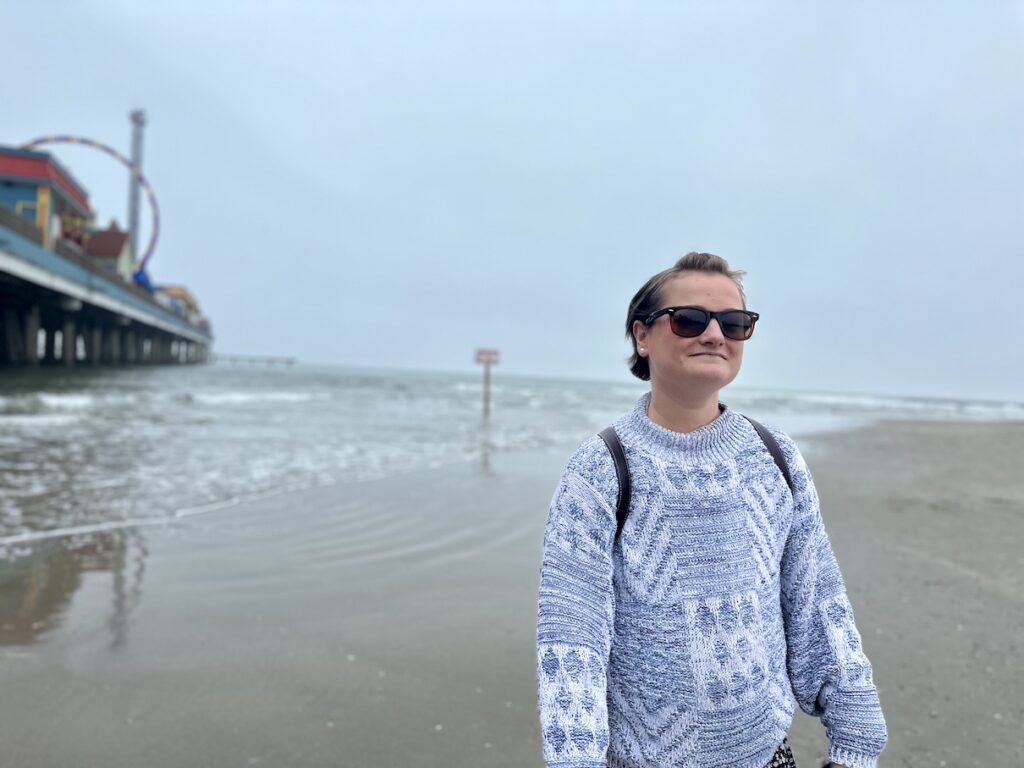
That was a lot of information! Glad you were able to enjoy your time there.
What a wonderful overview of your trip. Thank you for sharing everything you learned. It was over my head but still very interesting. Glad the Tesla worked out well and you had a chance to have some fun too!
Momma K.
Just truly amazing, Lauren. I learned a lot from this post!
Definitely a worthwhile trip! Thanks for sharing all you learned at the conference. And the Tesla road trip report was appreciated, too! I’m sure the “boys” were happy to see you when you got home!
Most excellent, Julia. Interesting information about cancer AND the Tesla! You were positively radiant in the video and I look forward to smiling and giving you a thumbs up as I tootle by your face on the wall! I will pass my copy of the Methodist magazine to Kim and Doug in case they don’t receive it. That’s after I read it and rejoice in your successful survivorship.
I once read that cancer can be a good thing, and I embrace that concept in my personal life. However, I have not taken it to the level that you have. You, Julia, are and will continue to make a difference in the lives of so many cancer patients with your insight into the science of cancer and its mental and emotional aspects. I urge you, again to look into publishing your blog. I also urge you to register with a speakers bureau so that others may share your insights with groups interested in hearing your message as they, or their loved ones cope with cancer.
I know grandma would have loved to hear all about this julia, you make us so proud! Thanks for writing this all down. Keep fighting!